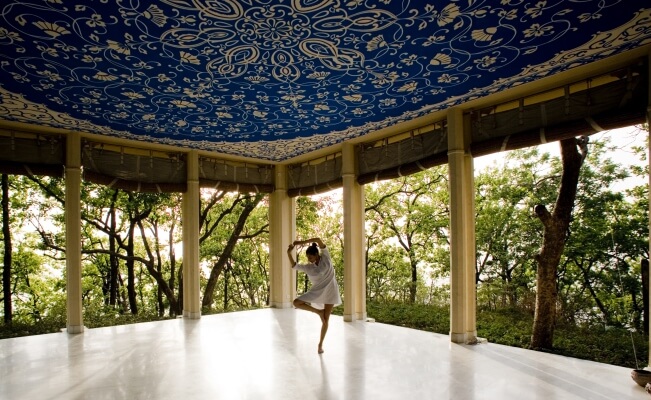On the Heroine’s Journey: Lost Femininity

© Ananda in the Himalayas
“There is a void felt these days by women and men– who suspect that their feminine nature, like Persephone[1], has gone to hell. Whenever there is such a void, such a gap or wound agape, healing must be sought in the blood of the wound itself. It is another of the old alchemical truths that ‘no solution should be made except in its own blood’. So the female void cannot be cured by conjunction with the male, but rather by an internal conjunction, by an integration of its own parts, by a remembering or a putting back together of the mother-daughter body.”
– Nor Hall, ‘The Moon and the Virgin’
When the goddess knocks on your door, she knocks loud and clear. I was 35 years old when She arrived in the form of Sydney-based psychotherapist and group facilitator, Jutka Freiman.
For many years before, Dr. Clarissa Pinkola Estes’ great tome of wisdom for women on the path to reclaim their wild, feminine nature, ‘Women Who Run with the Wolves‘ sat on my bookshelf. Like many women’s first experience of Dr. Estes’ epic balm for the feminine spirit, it was just too much for me to bite off at first. In retrospect, I was too young and hadn’t quite racked up enough battle scars, or yet realised how far I’d slipped out of my soul skin, to understand the lessons it held. That great gift would come later.
But there was something welling up in me that I couldn’t put my finger on. It took meeting Jutka and joining her yearlong Women’ Journeying program to realise I was responding to the urgent yearning to reconnect with the femininity that marks part of the Heroine’s Journey.
The Heroine’s Journey and the search for the lost femininity
In 1990, American author and Jungian psychotherapist, Maureen Murdock, published her roadmap for women’s lives, ‘The Heroine’s Journey: Woman’s Quest for Wholeness’. The book has since become a quintessential text for women on the quest to reclaim the lost (feminine) part of themselves.
Maureen wrote ‘The Heroine’s Journey’ in response to mythologist, Joseph Campbell’s book on the hero’s journey. As a student of Campbell’s work, Maureen felt his model did not address the specific psycho-spiritual journey of contemporary women. In 1983, she developed a model of the feminine journey based on her work with women in therapy. When she showed it to him, Campbell’s response was, “Women don’t need to make the journey. In the whole mythological journey, the woman is there. All she has to do is realise that she’s the place that people are trying to get to.”
Maureen didn’t buy it. She felt that the focus of spiritual development for modern women was to heal the internal split between woman and her feminine nature. “Women do have a quest at this time in our culture. It is the quest to fully embrace their feminine nature, learning how to value themselves as women and to heal the deep wound of the feminine,” she says in the introductory pages of ‘The Heroine’s Journey’.
Her model of the heroine’s journey – which has become a template for novelists, screenwriters, and those with a desire to understand the deep wounding of the feminine on both a personal and cultural level – begins with ‘separation from the feminine’ and ends with the ‘integration of masculine and feminine’. And it almost always starts with a yearning.
Responding to the call – the yearning
That yearning, or longing, is for what Dr. Estes describes as the Wild Woman archetype that speaks directly to woman’s deepest nature and instinctual psyche:
“We are all filled with a longing for the wild. There are few culturally sanctioned antidotes for this yearning. We were taught to feel shame for such a desire. We grew our hair long and used it to hide our feelings. But the shadow of Wild Woman still lurks behind us during our days and in our nights. No matter where we are, the shadow that trots behind us is definitely four-footed.”
Dr. Estes posits that:
“Healthy wolves and healthy women share certain psychic characteristics: keen sensing, playful spirit, and a heightened capacity for devotion. Wolves and women are relational by nature, inquiring, possessed of great endurance and strength. They are deeply intuitive, intensely concerned with their young, their mate and their pack. They are experienced in adapting to constantly changing circumstances; they are fiercely stalwart and very brave.”
She worries that the Wild Woman, like our great wilderness, is endangered. “The modern woman is a blur of activity. She is pressured to be all things to all people. The old knowing is long overdue,” she says. But she also knows on some level of her being that something is missing, “… We may have forgotten her names, we may not answer when she calls ours, but in our bones we know her, we yearn toward her; we know she belongs to us and we to her,” Dr. Estes says.
Myth and story as medicine for the soul
Dr. Estes, and other great feminist writers of our time – like Maureen Murdock and the author of ‘Goddesses in Every Woman’, Jean Shinoda Bolen – understand the power of fairy tales, myths and stories to help us understand ourselves and find our way back onto the path of our wildish nature.
“Traditional psychology is often spare or entirely silent about the deeper issues important to women: the archetypal, the intuitive, the sexual and cyclical, the ages of women, a woman’s way, a woman’s knowing, her creative fire,” Dr. Estes wrote in Singing Over the Bones (her Introduction to ‘Women Who Run with the Wolves’).”
In her introduction to ‘Goddesses in Every Woman’, Jean Shinoda Bolen described how powerful inner patterns (archetypes) are responsible for major differences among women – and that having knowledge of them provides a means to understanding ourselves, our relationships, our motivations, frustrations and yearning:
“When she knows which ‘goddesses’ are dominant forces within her, a woman acquires self knowledge about the strength of certain instincts, about priorities and abilities, about the possibilities of finding personal meaning through choices others might not encourage.”
Becoming a spiritual warrior
In the Greek goddess myths of Persephone[1], Artemis[2], Athena[3], Hestia[4], Hera[5], Demeter[6], Aphrodite[7] – and the thousands of others that live in other ancient and living cultures – we find ourselves. These stories are medicine. Through them we heal our sadness, we rediscover the lost parts of our creativity, we remember what our soul longs for and we are shown the path to follow it back home. To do this, we must become what Maureen Murdock refers to as ‘spiritual warriors’ in our quest:
“The heroine must become a spiritual warrior. This demands that she learn the delicate art of balance and have the patience for the slow, subtle integration of the feminine and masculine aspects of herself. First she hungers to lose her feminine self and to merge with the masculine, and once she has done this, she begins to realise that this is neither the answer nor the end. She must not discard nor give up what she has learned through her heroic quest, but learn to view her hard-earned skills and successes not so much as the goal but as one part of the entire journey.
Then she will begin to use these skills to work toward the larger quest of bringing people together, rather than for own individual gain. This is the sacred marriage of the feminine and masculine – when a woman can truly serve not only the needs of others but can value and be responsive to her own needs as well. This focus on integration and the resulting awareness of interdependence is necessary for each one of us at this time, as we work to preserve the balance of life on earth.”
And on Sacred Women’s Business …
The heroine’s journey is not an easy one to embark on, or a smooth ride even when you are on it. I, for one, know that regardless of how willing I am to let the shackles of my masculine conditioning fall away, I constantly slip of the path. I laugh (with some self-directed horror) thinking about Tantric teacher, Roxanna Minnona, saying to me, “Kris, it’s like you’ve got one foot on the accelerator and the other on the brake – you’re burning rubber, honey!”
That being said, it’s a journey I’m on – bumpy as it is – and one I’m sharing with you through Sacred Women’s Business. We need to share our stories to learn from, to be inspired by and to take solace in the challenges we come up against as we embark on our own individual heroine’s journey. Good luck!
[1] Persephone, maiden and queen of the underworld; expresses a woman’s tendency toward compliancy, passivity, and a need to please and be wanted by others.
[2] Artemis, goddess of the hunt and the moon; personifies the independent, achievement-oriented female spirit.
[3] Athena, goddess of wisdom and craft; represents the logical, self-assured woman who is rules by her head rather than her heart.
[4] Hestia, goddess of the hearth; embodies the patient and steady woman who finds comfort in solitude and exudes a sense of intactness and wholeness.
[5] Hera, goddess of marriage; stands for the woman who considers her roles as student, professional, or mother secondary to essential goal of finding a husband
[6] Demeter, goddess of grain and the maternal archetype; represents a woman’s drive to provide physical and spiritual sustenance for her children.
[7] Aphrodite, goddess of love and beauty, the ‘alchemical’ goddess governing a woman’s enjoyment of love and beauty, sexuality and sensuality; impels women to fulfil both creative and procreative functions.
This article was originally published on www.sacredwomensbusiness.com.


